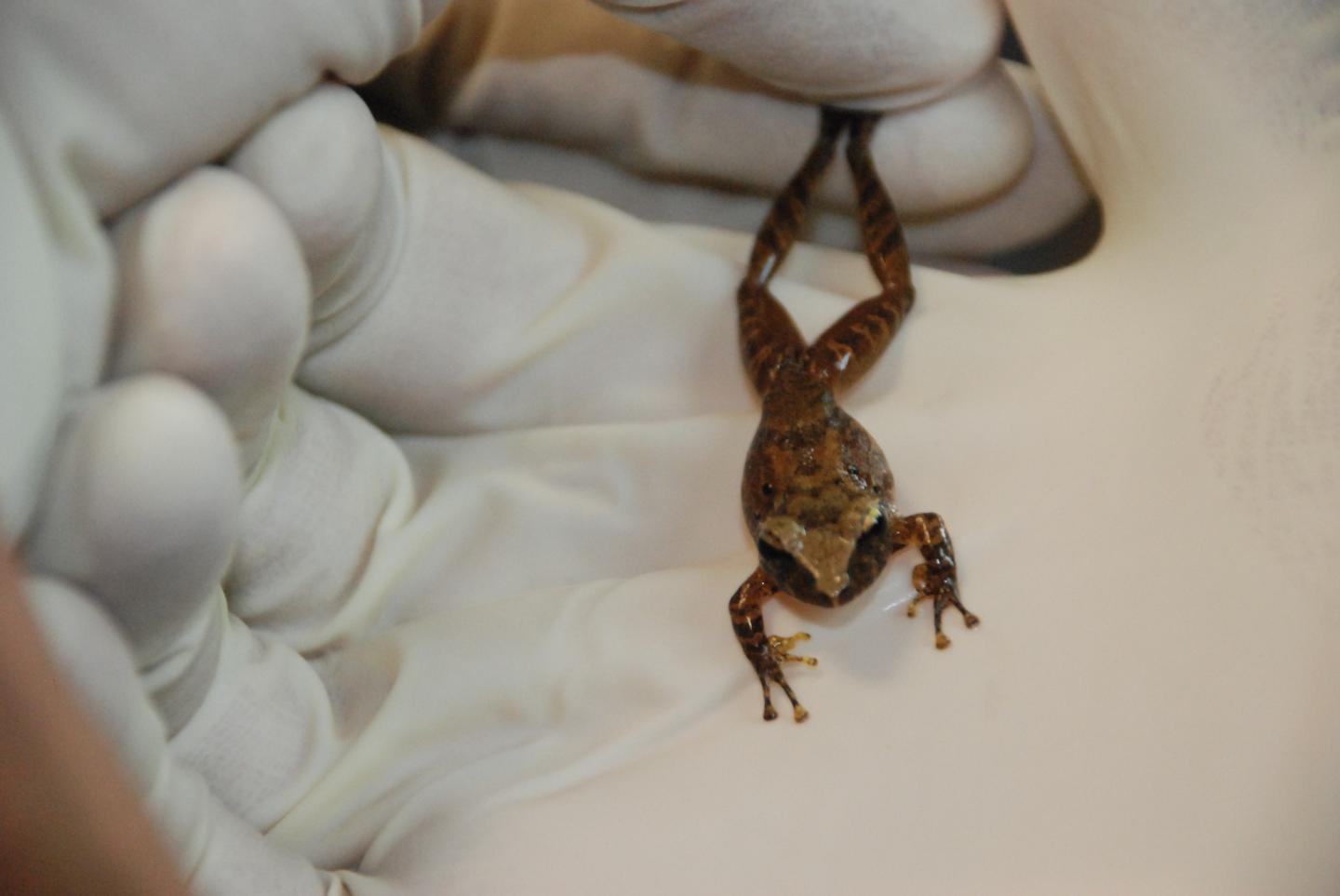
Credit: Christian Martin
In the past few decades, a lethal disease has decimated populations of frogs and other amphibians worldwide, even driving some species to extinction. Yet other amphibians resisted the epidemic. Based on previous research, scientists at the INDICASAT AIP, Smithsonian and collaborating institutions knew that skin bacteria could be protecting the animals by producing fungi-fighting compounds. However, this time they decided to explore these as potential novel antifungal sources for the benefit of humans and amphibians.
“Amphibians inhabit humid places favoring the growth of fungi, coexisting with these and other microorganisms in their environment, some of which can be pathogenic,” said Smithsonian scientist Roberto Ibáñez, one of the authors of the study published in Scientific Reports. “As a result of evolution, amphibians are expected to possess chemical compounds that can inhibit the growth of pathogenic bacteria and fungi.”
The team first travelled to the Chiriquí highlands in Panama, where the chytrid fungus, responsible for the disease chytridiomycosis, has severely affected amphibian populations. They collected samples from seven frog species to find out what kind of skin bacteria they harbored.
“Amphibians have glands scattered on their skin that produce different compounds,” Ibáñez said. “In addition, their skin is inhabited by a diverse community of bacteria that produce metabolites that inhibit the growth of fungi and other bacteria.”
Back in the laboratory, 201 bacterial strains were retrieved from their samples and tested against Aspergillus fumigatus, a fungus that causes invasive aspergillosis in immunocompromised patients. Of these, 29 showed antifungal activity, but one in particular caught their attention: a bacterium called Pseudomonas cichorii. This one showed the greatest potential to inhibit the growth of A. fumigatus.
After identifying the most promising bacteria, the scientists had a new question: among all the chemical compounds produced by P. cichorii, which one was keeping the fungi at bay? To find out, they used mass spectrometry and molecular networking techniques. They also observed the interactions between this bacteria and A. fumigatus to identify the bacterial compounds acting in areas where fungal activity was most inhibited. The main compounds were cyclic lipopeptides that included massetolides and viscosin.
The team then separated viscosin from the other components produced by P. cichorii and tested it invitro against A. fumigatus and the chytrid fungus. The results confirmed that viscosin displayed significant activity against both.
This research project holds promise for humans and frogs. Studying the skin bacteria of Panamanian frogs may lead to the development of alternative drugs to treat the fungi causing aspergillosis in humans, which are becoming more drug-resistant, and to defy the chytridiomycosis epidemic, the major source of disease-related death among amphibians worldwide.
“We are showing to the scientific community a set of possible alternative molecules to fight fungal drug resistance in humans,” said Christian Martin, the first author of the study along with the principal investigator Marcelino Gutiérrez, both from INDICASAT. “Although more studies are needed, our collaboration could spark interest in the conservation of amphibians as a novel source of bioactive compounds in humans. For amphibians, this is a promising study because there are only four bacterial secondary metabolites chemically described that inhibit chytrid fungi. In this study, we are introducing a new family of chemical compounds found in Panamanian frogs that could help amphibians worldwide.”
“I consider that bioprospecting compounds from skin secretions or bacteria living in frog’s skins is just beginning,” Ibáñez said. “This research has identified an antifungal compound produced by frog skin bacteria, which may be used to control pathogenic fungi affecting humans and amphibians. More research will be required to determine its potential medicinal use.”
###
Members of the research team are affiliated with the Centro de Biodiversidad y Descubrimiento de Drogas, Instituto de Investigaciones Científicas y Servicios de Alta Tecnología (INDICASAT AIP), Collaborative Mass Spectrometry Innovation Center at the Skaggs School of Pharmacy and Pharmaceutical Sciences at the University of California, San Diego, the Department of Pathology, Microbiology, and Immunology, Department of Pediatrics at Vanderbilt University School of Medicine and the Department of Biological Sciences at Vanderbilt University, and Smithsonian Tropical Research Institute,. Research was funded by the National Secretariat for Science and Technology of Panama (SENACYT) and National Science Foundation grant IOS-1557634.
The Smithsonian Tropical Research Institute, headquartered in Panama City, Panama, is a unit of the Smithsonian Institution. The Institute furthers the understanding of tropical biodiversity and its importance to human welfare, trains students to conduct research in the tropics and promotes conservation by increasing public awareness of the beauty and importance of tropical ecosystems. Website: http://www.
Media Contact
Leila Nilipour
[email protected]
Related Journal Article
http://dx.




